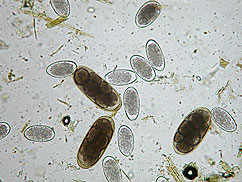Section Links
Risk diseases from new stock
Sheep scab / lice - These can be picked up in markets, even on lorries. Infected animals may not show any outwards or clinical signs.
Treatment options / advice : Injectable endectocide, dips or pour-on - seek professional advice
 Anthelmintic Resistant worms - Stock form farms with resistance will most probably carry resistant worms.
Anthelmintic Resistant worms - Stock form farms with resistance will most probably carry resistant worms.
Treatment options /advice : Follow SCOPS advice (Prevent them bringing anthelmintic resistant worms by giving them a drench with the 4-AD group or wormer (monepantel) AND moxidectin on arrival.
Note : If the moxidectin is the 1% injectable product this will also deal with the threat of sheep scab.
Fluke - replacements may be carrying fluke even if his is not present and a problem on your farm.
Treatment options /advice : Seek suitable advice for products to use to treat this parasite.
Consider - Using a Flukicide in September/October followed by a second treatment in December/January to remove late-developing stages.
Footrot - Always inspect feet on arrival and isolate any animals which show clinical signs to stop the possible spread of infection.
Treatment options /advice : Footbath or spray using a suitable product.. seek advice if necessary.
CLA (Caseous Lymphadenitis) - Check all animals carefully for any tell tale lumps, isolate any animals if any are seen .
Consult your vet for advice ASAP.
Orf - Check for signs and lesions around mouth and feet (coronet - top of the feet). Isolate animals for treatment.
Treatment options /advice : Seek veterinary advice for best treatment regimes. Use antibiotic sprays on raw lesions.. keep animals separate until healed.
EAE (Enzootic abortion) - There are no obvious clinical or outward signs of this disease (latent infection). Ewe lambs can pick up EAE when they are born in affected flocks. Shearlings may also have it when in contact with infected ewes and contracted the disease.
IMPORTANT : infected sheep are likely to abort and spread the disease further,
Treatment options /advice : NONE as such. You will not know until they abort at lambing. Bets advice is to buy from EAE accredited sources and vaccinate before tupping to reduce the incidence of abortion.
Best advice is to lamb the replacements separately until after their first lambing.
Border disease - There is a risk of introduction. Source anmals where the absence of dieases is known.
Advice. Where possible reduce the risk by keeping replacements separate until after lambing. Seek professional advice

